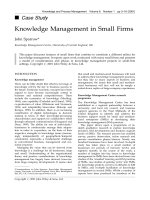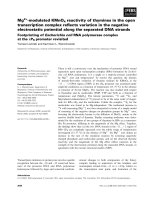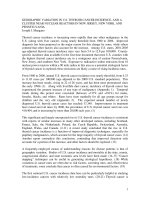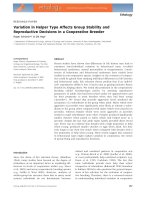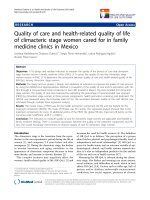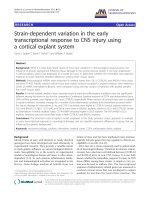Pay variation in family firms
Bạn đang xem bản rút gọn của tài liệu. Xem và tải ngay bản đầy đủ của tài liệu tại đây (2.36 MB, 209 trang )
Familienunternehmen und KMU
Jörg Schäfer
Pay Variation
in Family Firms
Familienunternehmen und KMU
Edited by
A. Hack, Berne
A. Calabrò, Witten/Herdecke
H. Frank, Vienna
F. W. Kellermanns, Charlotte, Vallendar
T. Zellweger, St. Gallen
Both Family Firms and Small and Medium Sized Enterprises (SME) feature a
number of distinct behaviors and characteristics which could provide them with
a competitive advantage in the market but could also lead to certain risks. The scientific series at hand presents research which provides an empirical and theoretical
contribution to the investigation on these specific characteristics and their impact
on business practice. The overall aim of this series is to advance the development of
theory in the areas of family firm and SME management.
Edited by
Professor Dr. Andreas Hack
University of Berne
Professor Dr. Hermann Frank
Vienna University of Economics and
Business
Professor Dr. Thomas Zellweger
University of St. Gallen
Professor Dr. Andrea Calabrò
University of Witten/Herdecke
Professor Franz W. Kellermanns,
Ph.D.
University of North Carolina Charlotte
WHU – Otto Beisheim School
of Management
Vallendar, Germany
Jörg Schäfer
Pay Variation
in Family Firms
Foreword by Prof. Dr. Andreas Hack
Jörg Schäfer
Witten/Herdecke, Germany
Dissertation Witten/Herdecke University, 2015
Familienunternehmen und KMU
ISBN 978-3-658-14546-0
ISBN 978-3-658-14547-7 (eBook)
DOI 10.1007/978-3-658-14547-7
Library of Congress Control Number: 2016942530
Springer Gabler
© Springer Fachmedien Wiesbaden 2016
This work is subject to copyright. All rights are reserved by the Publisher, whether the whole or part
of the material is concerned, specifically the rights of translation, reprinting, reuse of illustrations,
recitation, broadcasting, reproduction on microfilms or in any other physical way, and transmission
or information storage and retrieval, electronic adaptation, computer software, or by similar or
dissimilar methodology now known or hereafter developed.
The use of general descriptive names, registered names, trademarks, service marks, etc. in this
publication does not imply, even in the absence of a specific statement, that such names are exempt
from the relevant protective laws and regulations and therefore free for general use.
The publisher, the authors and the editors are safe to assume that the advice and information in this
book are believed to be true and accurate at the date of publication. Neither the publisher nor the
authors or the editors give a warranty, express or implied, with respect to the material contained
herein or for any errors or omissions that may have been made.
Printed on acid-free paper
This Springer Gabler imprint is published by Springer Nature
The registered company is Springer Fachmedien Wiesbaden GmbH
To my parents Ingrid and Peter, to my wife Ulrike and to my family.
Thank you for your love and for being always there for me.
Foreword
For years the issue of pay equity and pay dispersion has been discussed intensely and critically
on an economic but especially also on a socio-political level. However, this is not a new issue.
People have always been extremely sensitive to perceived equality of pay. Moreover,
important social developments such as the establishment of unions had, among others, their
origin in disputes about pay equality.
Yet, increasing discontent is perceivable in society with recent pay developments. Is this
due to the perceived “predomination” of anonymous public corporations in our economic
systems which are characterized by their orientation towards criteria of performance? What
does the reality look like when it comes to the companies that account for the largest share
in our economy, i.e. family owned businesses? Does the influence of entrepreneurial families
actually impact pay dispersion and thus the perceived equality of pay? In his thesis, Jörg
Schäfer addresses this "historic" but still red-hot issue of personnel management which
unfolds its power deep into the socio-political debate.
Besides this focus on personnel management aspects, the paper opens up another
equally interesting area of research. For some decades, scientists have been investigating the
impacts of the influence of entrepreneurial families on economic decisions. This influence is
empirically approximated by means of relatively simple key figures, such as family property,
participation of family members in the company management or number of family
generations involved. The underlying value structures of the entrepreneurial family are mostly
disregarded. The thesis is based on this aspect and analyses the concrete influence of
socioemotional wealth (SEW) - considerations on pay-strategic decisions in detail.
Responding to the research questions raised is without doubt a highly ambitious project,
which Mr. Schäfer has mastered exceptionally well. Firstly, the author deals with the current
literature on both issues in a well-structured and highly informative manner. Secondly, and
this demonstrates the relevance of this thesis, Mr. Schäfer presents a comprehensive set of
original data on German family businesses which is unique in terms of quality and the amount
of information. The theoretically derived hypotheses can thus be tested empirically for the
first time.
VIII
Foreword
With his dissertation, Mr. Schäfer connects and answers two major research questions in
an innovative approach and provides a particular enhancement to the current discourse
pertaining to payment structures and also to the heterogeneity of family businesses and
especially to measuring the influence of families. Addressing two independent research areas
at the same time clearly increases the complexity of the argumentation and represents an
extraordinary challenge for a dissertation thesis. Jörg Schäfer meets this challenge with a
precise, well-structured and sophisticated research design which is based on a sound
theoretical basis. The scientific value of this thesis can hardly be overestimated.
Furthermore, it is a very courageous thesis since it puts previous research on family
companies into question. Hence, the thesis demands a lot of the international research
community, namely the fundamental reconsideration of its traditional research design.
I am certain that the present dissertation thesis will have a sustainable influence on
research about family businesses. Therefore, I hope that it will be broadly received in science.
But first and foremost, I hope that this thesis will find a diverse general readership because its
results demonstrate yet again that entrepreneurial families bear a particular responsibility for
a fairer world of employment.
Prof. Dr. Andreas Hack
Acknowledgements
This doctoral thesis project is ultimately a product of many people. Even though it was a major
challenge for me to compose it, it was probably also one of the best times in my life – and this
is true for many reasons. Apart from being able to live again, after five years of strategy
consulting, a different lifestyle dependent 99% on my own discipline and time management
(and to be in Brazil to see all of Germany’s games leading to the winning of the world soccer
cup), it was also largely due to the many people I was blessed to get to know and who
supported me that made this project a success in the end. Therefore, I would like to thank
those people explicitly as they definitely deserve.
First of all, I have to express my gratitude to Prof. Dr. Andreas Hack who had to endure
my being a non-standard, slightly more senior consultant, with all the problems and challenges
that go along with it regarding time planning and change in working mode to adapt to this
“new research world”. I am very grateful for his patience, support, guidance, availability
whenever I really needed him, and encouragement without which I would not have completed
this doctoral program. Having arrived at the goal line and knowing many colleagues telling
different stories, I cannot imagine anyone better. Of course, I would also like to explicitly thank
Prof. Dr. Marcel Hülsbeck for being my second reviewer and investing his time into this
project.
In line with my two reviewers it is at least as important to mention Dr. Nils Kraiczy of
the IOP in Bern who was something like my mentor. I would like to thank Nils for always
supporting me, for encouraging me when it was necessary, for just having fun (and trash talk)
to shift perspective and for providing me on many occasions with important knowledge and
information that was necessary to the successful completion of this thesis project.
Furthermore, I have to thank my friend Dr. Hannes Hauswald for recommending
Andreas Hack and his team to me, for telling me that doing this doctorate leave will be great
fun and interesting at the same time. The fun part is also true for my friend Dr. Thorsten
Schäffler.
It is also important to thank all those family businesses and family business members
that invested their time into answering my questionnaire and, thus, providing me with the
data I needed for this dissertation.
X
Acknowledgements
I would also like to thank Dr. Thomas Pijanowski, Annika Geyer, Tatjana Schutte,
Thomas Wittig and all the other researchers, staff and doctoral students at the WIFU and its
research colloquium for camaraderie, eating lunch with me in Düsseldorf, having so much fun,
providing such a constructive research atmosphere, and helping me whenever I was in need.
Further, I would like to thank my employer OC&C Strategy Consultants GmbH and its
partners for giving me this doctoral leave and all employees who had to endure me walking
through the office while they had to do “serious” work. Along those lines, I would also like to
thank my OC&C and research colleagues Hendrik Walter, Sebastian Schmidt and Matthias
Guffler who worked on their thesis projects while I worked on mine and who always supported
me, shared an office with me or just had fun with me.
Finally, I would like to thank all my friends for sharing their time with me and providing
the distraction I needed to again be productive. I hope I have not forgotten anyone but if you
feel like I did just feel thanked as well.
Dr. Jörg Schäfer
Contents
Foreword ........................................................................................................................ VII
Acknowledgements ......................................................................................................... IX
Contents .......................................................................................................................... XI
Figures............................................................................................................................ XV
Tables ........................................................................................................................... XVII
Abbreviations ................................................................................................................ XIX
1.
2.
Introduction .............................................................................................................. 1
1.1.
BACKGROUND, RELEVANCE AND RESEARCH QUESTION ............................................................. 1
1.2.
MOTIVATION AND RESEARCH PROBLEM ................................................................................ 3
1.3.
RESEARCH OVERVIEW OF THE DISSERTATION.......................................................................... 7
1.4.
THESIS STRUCTURE ......................................................................................................... 10
Theoretical framework: Definitions, theories, limitations .........................................13
2.1.
RESEARCH ON FAMILY FIRMS ............................................................................................ 13
2.1.1.
Basic definition of family firm .......................................................................... 13
2.1.2.
Socioemotional Wealth Concept ..................................................................... 18
2.1.3.
The FIBER Approach ......................................................................................... 25
2.1.4.
Proactive Stakeholder Engagement in family firms ......................................... 29
2.2.
RESEARCH ON PAY VARIATION – DEFINITION AND THEORIES ................................................... 35
2.2.1.
Basic definition of pay variation ....................................................................... 35
2.2.2.
Equity Theory ................................................................................................... 52
XII
Contents
2.2.3.
2.3.
Compensation in family firms .......................................................................... 56
2.3.2.
Pay variation in family firms ............................................................................. 61
3.1.
INTRODUCTION AND THEORETICAL BASE FOR HYPOTHESES DEVELOPMENT ................................. 71
3.2.
NORMATIVE SEW (FIBER) CONFIGURATION AND VERTICAL / HORIZONTAL PAY RANGE ............... 74
3.2.1.
Identification of family members and vertical / horizontal pay range ............ 78
3.2.2.
Binding social ties and vertical / horizontal pay range .................................... 81
3.2.3.
Emotional attachment and vertical / horizontal pay range ............................. 82
SYNOPSIS OF HYPOTHESIS................................................................................................ 85
Research methodology .............................................................................................88
4.1.
SETTING....................................................................................................................... 88
4.2.
DATA COLLECTION AND SAMPLE........................................................................................ 89
4.3.
MEASURES ................................................................................................................... 96
4.3.1.
Independent variables...................................................................................... 99
4.3.2.
Dependent variables ...................................................................................... 104
4.3.3.
Control variables ............................................................................................ 108
4.4.
5.
THESIS CONTRIBUTION ON IDENTIFIED RESEARCH GAPS .......................................................... 67
Pay variation in family firms – Derivation of hypotheses ...........................................70
3.3.
4.
RESEARCH ON PAY VARIATION AND COMPENSATION IN FAMILY FIRMS ....................................... 56
2.3.1.
2.4.
3.
Tournament Theory ......................................................................................... 54
DATA ANALYSIS TECHNIQUE ........................................................................................... 111
Research results ..................................................................................................... 114
5.1.
ANALYSIS ................................................................................................................... 114
5.2.
POST HOC ANALYSIS ..................................................................................................... 125
Contents
6.
XIII
Concluding discussion............................................................................................. 129
6.1.
DISCUSSION................................................................................................................ 129
6.2.
THEORETICAL IMPLICATIONS AND CONTRIBUTION ............................................................... 137
6.3.
IMPLICATIONS AND CONTRIBUTION FOR FAMILY FIRMS AND PRACTITIONERS ............................. 140
6.4.
LIMITATIONS AND IMPLICATIONS FOR FUTURE RESEARCH ..................................................... 144
6.5.
CONCLUSION .............................................................................................................. 149
Appendix ....................................................................................................................... 151
References..................................................................................................................... 161
Figures
Figure 1-1: Structure of dissertation ........................................................................................ 11
Figure 2-1: The SEW-PSE Model by Cennamo et al. 2012........................................................ 31
Figure 2-2: Types of pay variation by Gupta et al., 2012 ......................................................... 37
Figure 2-3: Reasons for pay variation by Gupta et al., 2012 .................................................... 44
Figure 2-4: A typology of pay dispersion by Downes et. al. 2014 (p. 57) ................................ 49
Figure 2-5: A theoretical model of four types of pay dispersion and organizational
performance by Downes et al. 2014 ................................................................................ 50
Figure 3-1: Research model with all hypotheses ..................................................................... 85
Figure 3-2: Conceptual embedding of theories ....................................................................... 86
Figure 4-1: Main analysis EFA - scree plot pay variation 3..................................................... 102
Figure 4-2: Overview dependent variables - pay variations .................................................. 107
Figure Appendix-1: EFA - Scree plot pay variation 2 .............................................................. 158
Figure Appendix-2: EFA - Scree plot pay variation 1 .............................................................. 158
Figure Appendix-3: EFA - Scree plot pay variation 4 .............................................................. 159
Tables
Table 2-1: Brief overview of pay variation theories not detailed throughout dissertation. ... 45
Table 2-2: Overview on research on framework of Downes et al. 2014 ................................. 51
Table 3-1: Detailed overview of hypotheses ............................................................................ 87
Table 4-1: Descriptive statistics – Firm size ............................................................................. 90
Table 4-2: Descriptive statistics - Family ownership ................................................................ 91
Table 4-3: Descriptive statistics – Firm age .............................................................................. 91
Table 4-4: Descriptive statistics – Industries ............................................................................ 92
Table 4-5: Descriptive statistics – controlling body ................................................................. 93
Table 4-6: Descriptive statistics - TMT member set-up ........................................................... 93
Table 4-7: Descriptive statistics - Top earning TMT member is family .................................... 94
Table 4-8: Descriptive statistics - Tenure of top earning TMT member .................................. 94
Table 4-9: Descriptive statistics - Firm positon of answerer .................................................... 95
Table 4-10: Control measures EFA – main analysis.................................................................. 97
Table 4-11: Control measures EFA – Data quality and preliminary analysis ........................... 98
Table 4-12: Summary of EFA results – pay variation 3 direct oblimin rotation ..................... 101
Table 4-13: Identification of family members with the firm – Construct and items ............. 103
Table 4-14: Binding social ties – Construct and items ........................................................... 103
Table 4-15: Emotional attachment of family members – Construct and items .................... 104
Table 4-16: General definitions of dependent variables ....................................................... 105
Table 5-1: Descriptive statistics and correlations – vertical pay range 1............................... 117
Table 5-2: Descriptive statistics and correlations - vertical pay range 2 ............................... 118
Table 5-3: Descriptive statistics and correlations - vertical pay range 3 ............................... 119
Table 5-4: Descriptive statistics and correlations - horizontal pay range 4 ........................... 120
XVIII
Tables
Table 5-5: Multiple regression analysis pay range 1-4........................................................... 121
Table 5-6: Overview hypotheses results ................................................................................ 124
Table 5-7: Post hoc analysis - multiple regression analysis pay range 3................................ 126
Table 5-8: Post hoc analysis - multiple regression moderation analysis pay range 3 ........... 127
Table Appendix-1: EFA results on pay variation 3 varimax rotation ...................................... 151
Table Appendix-2: EFA results on pay variation 1 varimax rotation ...................................... 152
Table Appendix-3: EFA results on pay variation 1 direct oblimin rotation ............................ 153
Table Appendix-4: EFA results on pay variation 2 varimax rotation...................................... 154
Table Appendix-5: EFA results on pay variation 2 direct oblimin rotation ............................ 155
Table Appendix-6: EFA results on pay variation 4 varimax rotation ...................................... 156
Table Appendix-7: EFA results on pay variation 4 direct oblimin rotation ............................ 157
Table Appendix-8: Multiple regression results pay range 1-4 - unstandardized B, SE and p 160
Abbreviations
ANOVA
Analysis of Variance
B
Binding social ties (FIBER dimension)
CEO
Chief Executive Officer
CFA
Confirmatory factor analysis
CI
Condition Index
CSR
Corporate Social Responsibility
Dr.
Doctor
e.g.
Exempli gratia (for example)
EFA
Exploratory factor analysis
E
Emotional attachment of family members (FIBER dimension)
Electronic mail
ET
Equity Theory
ExT
Expectancy Theory
et al.
Et alia (and others)
EUR
Euro
FIBER
Family control (F), Identification of family members with the firm (I),
Binding social ties (B), Emotional attachment (E), Renewal of family bonds
by dynastic succession (R)
F-PEC
Family power (P), experience (E), and culture (C)
HR
Human Resources
Hyp.
Hypothesis
I
Identification of family members with the firm (FIBER dimension)
ILM
Internal Labor Market Theory
i.e.
Id est (that is)
XX
Abbreviations
KMO
Kaiser-Meyer-Olkin measure of sampling adequacy
KPI
Key performance indicator
KSA
Knowledge, skills, abilities
M
Million(s)
n.a.
Not applicable
(ln)
Natural logarithm
OLS
Ordinary Least Squares
Prof.
Professor
PSE
Proactive Stakeholder Engagement
RDT
Resource Dependence Theory
SEW
Socioemotional Wealth
SM
Stakeholder Management
SME
Small and Medium Enterprises
TCE
Transaction Cost Economics Theory
TMT
Top Management Team
TT
Tournament Theory
US(A)
United States (of America)
VIF
Variance Inflation Factor
vs.
Versus
Wifu
Wittener Institut für Familienunternehmen / Witten Institute for Family
Business
WLI
Work-Life-Incentive Theory
WTA
Winner-Takes-All Theory
1. Introduction
1.1.
Background, relevance and research question
“CEOs Get Paid Too Much, According to Pretty Much Everyone in the World,” states the HBR
Blog Network (Gavett, 2014) in September 2014. The article, by Kiatpongsan and Norton
(2014), to be published in a forthcoming issue of Perspectives on Psychological Science,
addresses the public’s strongly perceived injustice between the ever rising compensation of
top managers and higher unemployment rates, pay cuts, economic crisis, and reduced social
security (Davis and Cobb, J. Adam, 2010; Hoskisson, Castleton, and Withers, 2009; Walsh,
2008). One of the reasons for this sensation of injustice can be seen in the statistic that allows
a CEO in Germany to earn 147 times the salary of a simple worker. When asked, study
respondents answered that in a “perfect world scenario” a CEO should only earn around 6.3
times as much (Kiatpongsan and Norton, 2014). Nevertheless, pay differences between top
earners in the top management team (TMT) and average workers or employees have risen
exponentially over the past decades (Mishel and Sabadish, 2012), independent of analyzing
individual or average TMT member versus average or lowest income level non-TMT
employees (Cowherd and Levine, 1992; Sapp, 2008). According to www.paywatch.org (AFLCIO, 2014) the CEO to worker pay ratio increased from 46 in 1983 to 331 in 2013 across the
US (2013 CEO to average worker pay ratio calculated based on AFL-CIO analysis of 350
available companies in the S&P 500. Average worker pay according to Bureau of Labor
Statistics data for production and nonsupervisory workers).
As a result, public interest and condemnation trigger an ever growing discussion in
media and society about managerial compensation and its commensurability, reaching its
climax in public referendums, as happened in Switzerland in 2013, challenging the
establishment with a 1:12 pay spread initiative (Federal Government of Switzerland, 2014). In
the US, the ongoing discussion led to passage of the Dodd-Frank Wall Street Reform and
Consumer Protection Act of 2010, requiring all publicly listed US firms to disclose their CEO to
employee pay variance ratios (Paletta, 2010). In Germany, in 2014, parliament passed a law
mandating minimum wages to secure a basic living standard (Federal Government of
Germany, 2014). The trend is also growing across the US (United States Department of Labor,
2014) and its cities as e.g. recently in Portland, Oregon (Commissioner Brad Avakian, 2014).
© Springer Fachmedien Wiesbaden 2016
J. Schäfer, Pay Variation in Family Firms, Familienunternehmen
und KMU, DOI 10.1007/978-3-658-14547-7_1
2
Introduction
Few topics in society and the corporate landscape, especially in Germany, (you just
don‘t talk about remuneration) are so taboo and therefore difficult to assess as remuneration;
there are few studies that shed light on this topic, even more so when it comes to privately
held firms. An example of how sensitive this topic is in Germany can be found in the need for
a court decision on whether employees are even allowed to talk about their remuneration
publicly (Landesarbeitsgericht Mecklenburg-Vorpommern, 2009). Regarding privately held
firms or family firms, it would be interesting to address whether the fairness debate is valid
only for non-family firms and if not, how it relates to the often fairer or more people-oriented
family firms. In addition, the pressure is not only bottom-up, from employees to management.
Many entrepreneurs experience are also grappling with difficult moral issues with their family
or non-family managers about compensation and are calling for support, as there are nearly
no benchmarks or guiding principles.
Because family firms are the industrial and corporate backbone of many economies,
especially in Germany where the “Mittelstand” represents 99.7% of firms and 60% of all
employees are employed (Federal Ministry of Economics and Technology in Germany, 2014),
I focus in particular on family firms and the predictors of pay variation there. In this
dissertation I want to answer the following key questions:
What are the antecedents of pay variation in a family firm environment, and what factors
drive different family firms to pursue and implement specific pay structures and pay
variations?
What differentiates pay variation between family firms, e.g. regarding family firm or
owner-family specific drivers or regarding family dynamics such as management
composition?
Introduction
1.2.
3
Motivation and research problem
Gupta, Conroy, and Delery (2012) state that "the study of pay variations is no longer nascent.
It is time to study it in a cautious, detailed, nuanced manner." (Gupta et al., 2012: 113). Even
though pay variation may no longer be in its beginnings, there are still blank voids where
research is inconsistent, such as in the area of pay variation’s effect on corporate efficiency
and effectiveness and a lack of research on triggers, predictors and antecedents (Downes and
Choi, 2014; Gupta et al., 2012). However, research is clear about the importance of pay
variation when it comes to firms and their employees (Connelly, Haynes, Tihanyi, Gamache,
and Devers, 2013; Heyman, 2005), applying theories that describe the causes of pay variation.
These applied theories move along the continuum of more equity, fairness and equality-driven
concepts towards more competition, tournament, and “winner-takes-all” oriented concepts.
However, pay variation is only one side of this dissertation. In recent decades, research
has identified the major importance of family firms for the global economy (Anderson and
Reeb, 2003; Astrachan and Shanker, 2003; Klein, 2000), and their substantial distinction from
non-family firms (Sharma, 2004). Furthermore, literature provides a body of evidence that
deals with family firm specific aspects of firm management and control, and has striven to
prove its value for family firm research (Sharma, Chrisman, and Gersick, 2012) by identifying
differentiators not only between family and non-family firms, but also within this
heterogeneous group across many countries (Chrisman, Chua, and Litz, 2004; Gomez-Mejia,
Cruz, Berrone, and Castro, 2011; Zellweger, Kellermanns, Chrisman, and Chua, 2012).
One of the most recent approaches applied in family firm literature can be found in
the Socioemotional Wealth (SEW) concept, which claims that family firms base their actions
on a quite different rationale one that is not necessarily economically rational but is intended
to preserve socioemotional wealth endowment. Examples can be found in owner families
taking business decisions that jeopardize profitability or even firm survival in favor of including
the next family generation in leadership or maintaining public image and reputation to
preserve this endowment (Berrone, Cruz, and Gomez-Mejia, 2012; Berrone, Cruz, GomezMejia, and Larraza-Kintana, 2010; Gomez-Mejia et al., 2011; Gómez-Mejía, Haynes, NúñezNickel, Jacobson, and Moyano-Fuentes, 2007). Berrone et al. (2012) define SEW as "an allencompassing approach that captures the “affective endowment” of family owners, including
the family’s desire to exercise authority, enjoyment of family influence, maintenance of clan
4
Introduction
membership within the firm, appointment of trusted family members to important posts,
retention of a strong family identity, continuation of the family dynasty, and so on" (Berrone
et al., 2012: p. 262).
The SEW concept was detailed and divided into separate dimensions called FIBER. This
concept stands for owner families striving to maintain control over the firm (F), identify
strongly with the firm (I), have strong and binding social ties with key stakeholders (B), be
strongly emotionally attached (E) to the firm and each other as well as achieve an assured
family succession (R) (Berrone et al., 2012). This separation implies that family firms value
multiple salient goals including such factors as public image, corporate social responsibility,
community integration, employee satisfaction, among others.
Additionally, the SEW and FIBER approach were extended by a concept called Proactive Stakeholder Engagement (PSE) (Cennamo, Berrone, Cruz, and Gomez-Mejia, 2012),
stating that the more families that strive for SEW, the more stakeholder needs are proactively
integrated into firm strategy and operative decision making. However, research shows that
this is not necessarily a positive connection, as SEW can show positive and negative valence
(Hauswald and Hack, 2013; Kellermanns, Eddleston, and Zellweger, 2012b). The PSE concept
by (Cennamo et al., 2012) separates the FIBER items into normative (I,B,E) and instrumental
(F,I,R) items where the normative ones in particular may influence pay variation as there is a
significant moral aspect in doing things because they are right and not because of a clear
instrumental intention; actions are taken in order to maintain public image and reputation as
a SEW endowment.
As a result, the family firm literature with its SEW and FIBER concepts still needs to be
directly measured and applied and the research on pay variation is still incomplete.
Consequently, one of the goals of this dissertation is to bridge those research streams and
describe how the conjoint effort provides added value. Both ongoing conversations present
an opportunity to dig deeper and provide answers for the research topic.
With the exception of some recent papers by Connelly et al. (2013) and Jaskiewicz,
Block, Miller, and Combs (2014), the antecedents of pay variation have not been extensively
researched, leaving vast areas for speculation (Gupta et al., 2012; Jirjahn and Kraft, 2007).
Even though the effects of pay variation have been better researched, their direction and
significance are often inconsistent (Downes and Choi, 2014; Gupta et al., 2012). Moreover,
Introduction
5
vertical pay variation as well as range variables, explaining reactions of employees better than
dispersion measures (Gupta et al., 2012) are largely neglected areas of research. This lack of
knowledge exists despite Shaw, Gupta, and Delery’s (2002) having identified corporate pay
structures as one of the most, if not the most, important HR dimension when looking at
corporate strategy implementation (Montemayor, 1996). This importance is based on the
massive cost connected to employee compensation (Shaw et al., 2002) and the impact HR
policies have on corporate strategy implementation and thus corporate performance. (Lawler,
1981) Therefore, by providing further research on antecedents in pay variation, I answer the
call in literature to unearth these drivers (Connelly et al., 2013) and contribute
methodologically by fostering research on vertical pay variation by applying range measures.
While there are many proofs of concept and different aspects in which socioemotional
wealth dominates financial aspects, neither the SEW nor the FIBER concept has yet been
directly measured and methodically validated, even though a possible approach was provided
by Berrone et al. (2012). Most empirical studies apply secondary, univariate variables such as
family ownership, family member presence on the boards, etc. as indirect proxies to measure
the degree of familiness and the resulting SEW potential (Berrone et al., 2012). Additionally,
regarding PSE, the focus lies strongly on the positive valence of the FIBER dimensions. The
negative valence has not been stressed so far and an application in quantitative research and
an empirical validation providing significant examples are still missing.
Thus, the SEW and PSE concepts are still in the testing phase and pay variation
antecedents are yet to be researched. Therefore, conducting further research on those
theoretical constructs incorporates important further aspects to each research stream and
contributes to family firm concept and theory validation as well as sheds more light on
antecedents of pay variation. Especially regarding family firms, a key challenge is that they just
do not know what influences their compensation structures especially on a top management
level and how their striving to preserve their SEW endowment influences their stakeholder
management and pay structures as a consequence. Thus, I satisfy the demand from influential
researchers in the family firm environment to enhance cross-disciplinary knowledge (Zahra
and Sharma, 2004) and to take into consideration special characteristics of family firms
regarding human resources (Sharma, 2004). Furthermore, we may also learn whether less pay
variation also influences a family firm environment’s long-term corporate success as indicated
by Connelly et al. (2013) for US firms and if family-related drivers cause family firms to
6
Introduction
implement fairer pay structures thus adding to family firm literature by identifying family
specific success drivers and supporting the heterogeneity discussion.
Introduction
1.3.
7
Research overview of the dissertation
I develop and test empirical explanations of antecedents of pay variation in a German family
firm environment. Existing pay variation research suggests, that ownership by "dedicated
institutional investors (who have longer investment time horizons and equity stakes in fewer
firms) negatively influence pay dispersion" (Connelly et al., 2013: p. 1), measuring vertical pay
variation on a S&P 1500 publicly listed firm sample (Connelly et al., 2013). Regarding
horizontal non-CEO TMT pay variation Jaskiewicz et al. (2014) found that in a S&P 500 publicly
listed firm sample, pay variation increases in family firms over the life of the firm starting from
founder firms onward to later generations due to less goal alignment. As family owners clearly
fall into the long-term orientation category, smaller pay variations are generally to be
expected (Connelly et al., 2013) vertically for family firms and horizontally as founder
ownership diminishes (Jaskiewicz et al., 2014). However, as the research focuses solely on the
heterogeneity of family firms, there is a need to determine the differentiators driving family
firm specific behavior. Therefore, as the normative elements of the FIBER concept should lead
to an improved Pro-active Stakeholder Engagement and result in a narrower focus on CSR,
image, reputation, and community interaction, among others (Cennamo et al., 2012), pay
variation should be negatively related. As a consequence, I investigate a model that measures
the influence of the normative FIBER items I, B, E on vertical TMT versus employee (employees
performing different jobs across hierarchies), and horizontal intra-TMT (employees
performing the same job) pay variation. Additionally, I analyse the influence of family firm
specific aspects on pay variation, such as the influence of family membership in the TMT and
the existence of a board of directors.
Our results confirm that the normative dimensions do influence pay variation both
vertically and horizontally. Identification of family members with the firm shows a consistent
negative influence on vertical pay variation, whereas it has no significant effect on horizontal
pay variation. Binding social ties are also negatively related to vertical pay variation, even
though not always significantly, but show a contradicting influence when looking at horizontal
intra-TMT pay variation. Emotional attachment shows almost no significant effects, apart from
vertical pay variation 3 (average TMT members vs. average non-TMT members) where a
positive relation may indicate a negative SEW valence adding to SEW but influencing
stakeholder demands negatively and thus resulting in higher pay variation. As a result, I can
